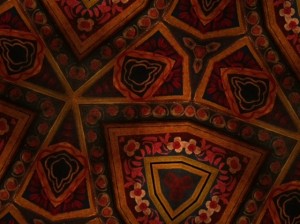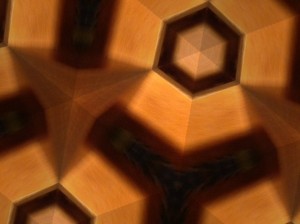Inspiring Interior Design (Part 14)
By Asher Crispe: August 23, 2012: Category Inspirations, Quilt of Translations
Designing with Color
Color changes everything. We don’t experience the world in only black and white. Seeing a black and white image is often a giveaway that I am not looking directly at the ‘real world.’ Truth be told, the relationship between black and white and color is a complex one. It is bound up with our perception and psychology, science and aesthetics, the material and the immaterial. We will begin with a general discussion of color and then attempt to focus it on the subject of interior design in the course of the next few installments in our series.
Charles A. Riley has written a concise overview of the history of color entitled Color Codes which captures some of its diverse applications and implications for philosophy, art, architecture, music and literature. We will contend with one of his opening remarks as a means of setting the stage for our subsequent discussion (p.1):
“The first thing to realize about the study of color in our time is its uncanny ability to evade all attempts to codify it systematically. The sheer multiplicity of color codes attests to the profound subjectivity of the color sense and its resistance to categorical thought. Color behavior does not conform to one paradigm, chart, or episteme.”
The same limitations hold true for the kabbalistic modeling of color. Outlining its parallels to different spiritual realities and powers of the soul proves difficult–with one significant difference. Kabbalah is able to bridge multiple color codes and demonstrate connections between systems of color correspondence. To do justice to the issue would require a book-length treatise, so for now we will have to suffice with an adumbration.
To date, the repository for the most sustained reflection on the nature of color appears in the Tenth Gate of the Pardes Rimmonim of Rabbi Moshe Cordovero (the Remak 1522-1570). Also known as the Gate of Colors, in this chapter he sets up a web of relationships between the emotive spheres of the soul and a basic array of colors. This ‘color coordination’ is by no means the first or last word on the subject in Jewish mysticism. However, the Remak may have handed us the most basic piece of information needed in order to assemble a more fully formed system of color. This system, we should emphasize, retains an openness to it and make no pretense of providing an synoptic version of kabbalistic color theory. Only in relative terms does it endure intelligibly and spark reflection upon reflection.
What the Remak lays down for us is the idea that colors correlate with the seven emotions. The emotional landscape is colored, and perhaps more importantly, emotions color the landscape. Viewed through an emotional lens, the world seems different. It has become subjected to our feelings about it or even just our feelings at the time. So too, with respect to the topographies of the soul–a person’s inner thought processes, which manufacture concepts and hang them in the hallways of the mind as a gallery of mental representations, may also become colored. In other words, color often serves as a stand in for subjectivity. The neutrality of the objective world resides in black and white, while comparatively speaking, color introduces our bias, our non-indifference and our individual viewpoint.
Why else would the first human being (who represents the primordial human condition) Adam be given a name which means ‘red’ (adom). This first identifying feature of humanity is bound up with color. We add color to the universe. In and of themselves, the heavens and the earth may be colorless objects. Yet in order for someone to know them, to have a view from somewhere (not a Godlike view from nowhere), we have to observe them from the perspective of our corporality which localizes human consciousness.
Sometimes in Kabbalah the figure of Adam (Adom) is likened to a set of coordinates–the va’k or vav kitzavot meaning the six extremities of space: up/down, right/left/, front/back. Why would the human condition be compared to spatiality in this manner? The reason is that we are anchored in our place. Our eyes (I’s) are not detachable. I cannot elect where to position them. They are seated in my head which is attached to my body which is standing over ‘here’ and not over ‘there.’ My perspective on everything is therefore situated. ‘Situatedness’ as my ‘spatial orientation’ means that I can only relate to an object from where I am at. This object is subjected to all that ‘I’ am.
 Perspectival thinking or perspectivism means the inescapable way in which I must always regard the world from my particular perspective. ‘I’ enter into the mix. There is no known object with out a subjectivity coloring it in. ‘I’ am superadded to its details and features. As a result, the knowledge that I take away is some form of hybridization of the subject and object.
Perspectival thinking or perspectivism means the inescapable way in which I must always regard the world from my particular perspective. ‘I’ enter into the mix. There is no known object with out a subjectivity coloring it in. ‘I’ am superadded to its details and features. As a result, the knowledge that I take away is some form of hybridization of the subject and object.
In sum, our symbolic universe contains black and white as the comparatively objective sense of phenomena, while color suggests the introduction of certain impurities that taint the food of perception. At the same time, we do not want to imply that subjectivity or color is a negative thing. If anything, photographers know that there is a time to shoot in black and white and a time for color. Each has their respective advantages and disadvantages. Each bring something new to the fore.
Now that our inner experience of black and white verses color has been flagged as a question of the relationship between the objective and the subjective, the pure intellect and the emotions, the relatively unsituated perspectiveless transcendental perception verses the situated acquisition of knowledge, we can turn our attention towards applications of this distinction. Designers who reflect upon the psychodynamics herein are sure to think twice about the choice of coloration beyond its immediate gratification of the senses.
For Part Fifteen of our series we will run through a number of examples that accentuate the nature of black and white along with color.
http://www.interinclusion.org/inspirations/inspiring-interior-design-part-15/
























;)
;)
;)
;)
;)
;)
;)
;)
;)
;)
